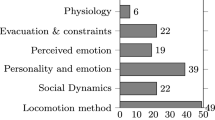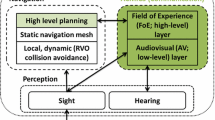Abstract
In this paper, we propose an agent-based model for crowd simulation. It is made up of two types of agents that act differently: collaboratives, which share information about the paths and/or repair the ones that have been damaged, and defectors, who share no information, destroy some paths and/or nodes, and take advantage of the collaborative agents’ guidance. The aim of the model is to investigate how the agents who engage in these two activities affect one another and, ultimately, on the collective behavior of the crowd. For both kinds of agents, three evaluation metrics have been considered: (i) the number of agents that have reached the exit; (ii) paths’ costs; and (iii) exit times. According to the data analysis, the presence of defectors is essential in improving the agents’ performance. Indeed, when both collaborators and defectors are present in the crowd, more agents exit, and their average path costs and average exit times are lower than when only collaborative agents are present.
Access this chapter
Tax calculation will be finalised at checkout
Purchases are for personal use only
Similar content being viewed by others
References
Bosse, T., Hoogendoorn, M., Klein, M.C.A., Treur, J., van der Wal, C.N., van Wissen, A.: Modelling collective decision making in groups and crowds: integrating social contagion and interacting emotions, beliefs and intentions. Auton. Agent. Multi-Agent Syst. 27(1), 52–84 (2013). https://doi.org/10.1007/s10458-012-9201-1
Consoli, P., Collerà, A., Pavone, M.: Swarm intelligence heuristics for graph coloring problem. In: 2013 IEEE Congress on Evolutionary Computation, pp. 1909–1916 (2013). https://doi.org/10.1109/CEC.2013.6557792
Consoli, P., Pavone, M.: O-BEE-COL: optimal BEEs for COLoring graphs. In: Legrand, P., Corsini, M.-M., Hao, J.-K., Monmarché, N., Lutton, E., Schoenauer, M. (eds.) EA 2013. LNCS, vol. 8752, pp. 243–255. Springer, Cham (2014). https://doi.org/10.1007/978-3-319-11683-9_19
Crespi, C., Fargetta, G., Pavone, M., Scollo, R.A.: an agent-based model to investigate different behaviours in a crowd simulation. In: Mernik, M., Eftimov, T., Črepinšek, M. (eds.) BIOMA 2022. LNCS, vol. 13627, pp. 1–14. Springer, Cham (2022). https://doi.org/10.1007/978-3-031-21094-5_1
Crespi, C., Fargetta, G., Pavone, M., Scollo, R.A.: How a different ant behavior affects on the performance of the whole colony. In: Di Gaspero, L., Festa, P., Nakib, A., Pavone, M. (eds.) MIC 2022. LNCS, vol. 13838, pp. 187–199. Springer, Cham (2023). https://doi.org/10.1007/978-3-031-26504-4_14
Crespi, C., Fargetta, G., Pavone, M., Scollo, R.A., Scrimali, L.: A game theory approach for crowd evacuation modelling. In: Filipič, B., Minisci, E., Vasile, M. (eds.) BIOMA 2020. LNCS, vol. 12438, pp. 228–239. Springer, Cham (2020). https://doi.org/10.1007/978-3-030-63710-1_18
Crespi, C., Scollo, R.A., Pavone, M.: Effects of different dynamics in an ant colony optimization algorithm. In: 2020 7th International Conference on Soft Computing Machine Intelligence (ISCMI 2020), pp. 8–11. IEEE (2020). https://doi.org/10.1109/ISCMI51676.2020.9311553
DeAngelis, D.L., Diaz, S.G.: Decision-making in agent-based modeling: a current review and future prospectus. Front. Ecol. Evol. 6, 237 (2019). https://doi.org/10.3389/fevo.2018.00237
Drury, J., et al.: Cooperation versus competition in a mass emergency evacuation: a new laboratory simulation and a new theoretical model. Behav. Res. Methods 41, 957–970 (2009). https://doi.org/10.3758/BRM.41.3.957
Khamis, N., Selamat, H., Ismail, F.S., Lutfy, O.F., Haniff, M.F., Nordin, I.N.A.M.: Optimized exit door locations for a safer emergency evacuation using crowd evacuation model and artificial bee colony optimization. Chaos Solitons Fractals 131, 109505 (2020). https://doi.org/10.1016/j.chaos.2019.109505
Peng, Y., Li, S.W., Hu, Z.Z.: A self-learning dynamic path planning method for evacuation in large public buildings based on neural networks. Neurocomputing 365, 71–85 (2019). https://doi.org/10.1016/j.neucom.2019.06.099
Pintea, C.-M., Matei, O., Ramadan, R.A., Pavone, M., Niazi, M., Azar, A.T.: A fuzzy approach of sensitivity for multiple colonies on ant colony optimization. In: Balas, V.E., Jain, L.C., Balas, M.M. (eds.) SOFA 2016. AISC, vol. 634, pp. 87–95. Springer, Cham (2018). https://doi.org/10.1007/978-3-319-62524-9_8
Shi, X., Ye, Z., Shiwakoti, N., Tang, D., Lin, J.: Examining effect of architectural adjustment on pedestrian crowd flow at bottleneck. Phys. A 522, 350–364 (2019). https://doi.org/10.1016/j.physa.2019.01.086
Siyam, N., Alqaryouti, O., Abdallah, S.: Research issues in agent-based simulation for pedestrians evacuation. IEEE Access 8, 134435–134455 (2020). https://doi.org/10.1109/ACCESS.2019.2956880
van der Wal, C.N., Formolo, D., Robinson, M.A., Minkov, M., Bosse, T.: Simulating crowd evacuation with socio-cultural, cognitive, and emotional elements. In: Mercik, J. (ed.) Transactions on Computational Collective Intelligence XXVII. LNCS, vol. 10480, pp. 139–177. Springer, Cham (2017). https://doi.org/10.1007/978-3-319-70647-4_11
Varghese, E.B., Thampi, S.M.: Towards the cognitive and psychological perspectives of crowd behaviour: a vision-based analysis. Connect. Sci. 33(2), 380–405 (2021). https://doi.org/10.1080/09540091.2020.1772723
Wang, S., Liu, H., Gao, K., Zhang, J.: A multi-species artificial bee colony algorithm and its application for crowd simulation. IEEE Access 7, 2549–2558 (2019). https://doi.org/10.1109/ACCESS.2018.2886629
Wilensky, U.: NetLogo. Center for Connected Learning and Computer-Based Modeling, Northwestern University, Evanston, IL (1999). http://ccl.northwestern.edu/netlogo/
Yücel, F., Sürer, E.: Implementation of a generic framework on crowd simulation: a new environment to model crowd behavior and design video games. Mugla J. Sci. Technol. 6, 69–78 (2020). https://doi.org/10.22531/muglajsci.706841
Author information
Authors and Affiliations
Corresponding author
Editor information
Editors and Affiliations
Rights and permissions
Copyright information
© 2023 The Author(s), under exclusive license to Springer Nature Switzerland AG
About this paper
Cite this paper
Crespi, C., Fargetta, G., Pavone, M., Scollo, R.A. (2023). An Agent-Based Model for Crowd Simulation. In: De Stefano, C., Fontanella, F., Vanneschi, L. (eds) Artificial Life and Evolutionary Computation. WIVACE 2022. Communications in Computer and Information Science, vol 1780. Springer, Cham. https://doi.org/10.1007/978-3-031-31183-3_2
Download citation
DOI: https://doi.org/10.1007/978-3-031-31183-3_2
Published:
Publisher Name: Springer, Cham
Print ISBN: 978-3-031-31182-6
Online ISBN: 978-3-031-31183-3
eBook Packages: Computer ScienceComputer Science (R0)




